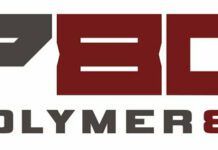Where is no end to debate concerning handgun sights and their use. Personal preference plays a role, but a poor choice in a defensive handgun may have serious consequences. Good enough and bargain basement dont cut it. Even the use of sights is debated. Some argue for point shooting or instinctive fire at close range. Unsighted fire sounds like a disaster waiting to happen. The keys to accurate fire include smooth trigger compression, proper sight alignment and proper sight picture. Area aiming or aiming for the whole target is not going to get the job done.
For most gun-buyers, sights are a make-or-break part of the purchase, as important as the cartridge. Sights can-and should-influence which guns you buy. Also, on guns you already own, you can upgrade the sights, especially 1911s and Glocks-if you know what works, and what doesnt. A person who purchased the best pistol he could afford at the time may wish to upgrade to better sights at a later date, but how does he know what to choose?
We wanted to compare the execution of several sights found on existing factory guns and as aftermarket products to see which one offered the best combination of sight quality, ease of presentation, and durability. This is a tricky job description for a sight, because those requirements can be contradictory. In the past the shortcomings of pistol sights were understood. A universal fault was the round front sight. Where was the top of the sight? Sight pictures were not repeatable. About 1923 a Western peace officer named Tom Threepersons had a square and tall front sight added to his 4.75-inch-barrel Colt Single Action Army. Better sights followed.
Among the first practical high-visibility handgun sights were Kings Hardballer sights. They raised the sight picture and offered an improvement over small GI sights. The problem with fitting combat sights on a self-defense gun is the height of target-type sights. Too-tall front and rear sights became so obtrusive the handgun became difficult to holster. If you use a rear sight that sets tall above the frame, then the front sight must have a correspondingly high profile. The revolution came with Wayne Novaks Lo Mount
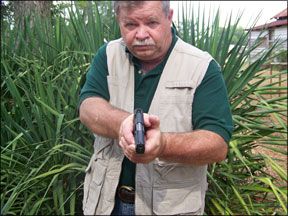
sights. Designed like a pyramid, these sights require a special mounting cut in the slide to ride low. The front sight may be as low as .200 inch, although a .249 sight is also used.
Reducing the vertical profile of a sight is important because adjustable sights are exposed to all manner of insult and are relatively fragile. If you visit a police department, you notice that the area around the door jamb of the squad room is often beaten up. This is because that is hip level, and cops guns, especially the sights, take a beating on doorways. And, of course, sights are rubbed on by holsters, and they may impede drawing the weapon when you need it most.
To consider these issues, we looked at nine different common sight styles on a host of guns. GI sights, Mil Spec sights, Trijicon sights, XS big dot sights, Novak sights, Heinie sights, McCormick sights, Para Ordnance sights, and Wilson Combat sights.
Test Program
To evaluate specific sight brands in the areas we thought were most important, we divided the test into four areas-snag testing, short-range firing, mid-range firing, and long-range testing.
Testing something as subjective as handgun sights is difficult. It is easy to confirm that Novak sights work better than GI sights, but the nuances of the better handgun sights are quite different. Some sights, such as the XS big-dot type, are specialized, while others are for general use. We had to consider not only how they performed, but how they performed at both long and short range. Another question was, were the sights free of snags? Personal-defense sights could not snag on clothing during the draw.
To evaluate GI sights, our testers used a Springfield GI, Rock Island GI, High Standard 1911, and a nickel-plated RIA 38 Super. Our Mil Spec-sight-equipped guns were a Springfield Mil Spec and a Colt 1911 Series 80. Our test guns wearing Trijicon sights were a High Standard 1911 and a Smith & Wesson M&P 9mm. We used two guns with XS big dot sights, a Glock and a Browning Hi-Power. We had quite a few guns with Novaks, including a Springfield TRP with night insert, Springfield Loaded Model with night insert, Caspian custom with fiber-optic front sight, Springfield Novak Custom with gold bead front, and a High Standard Crusader with black sights. We had three Taurus pistols with Heinie sights, the 24/7 9mm, 24/7 45 ACP, and Taurus PT 1911 45 ACP, and an Action Works Colt. McCormick-sighted guns were the Kimber Pro Carry and Kimber Custom II. The Para Ordnance guns with factory sights were the SSP and 7.45. Gun with the Wilson Combat sights with night inserts were on a High Standard G-Man, a RIA 38 Super, and a Glock M17 9mm.
To save money and ensure we had enough rounds of our test ammos on hand without having to buy identical lots of ammo, we mainly shot handloads for much of the test program, including the Oregon Trail 230-grain RNL bullet with enough TiteGroup powder for 830 fps. We also used Winchester USA 230-grain ball ammunition in the 45 ACP. In the 40-caliber Glock, we used Winchester 180-grain SXT, and in the 9mm High Power with XS sights, we used Winchester 115-grain FMJs for close-range work and Winchester 147-grain SXTs at longer range.
Sights: Bright/Dim Light Conditions
Before we get to specific comparisons below, we should first get to a few general questions about sight types that many shooters have: Do night sights work in bright light? Are tritium night sights good for all-round use? Is glare a problem on stainless sights?
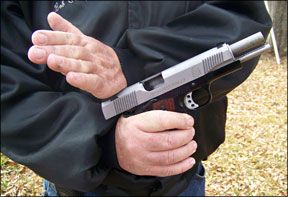
It is difficult but not impossible to find a range at which it is possible to test night sights. We were able to test the configurations and to confirm or defy myths concerning night sights. During the night-firing tests of 45s, we found we needed a low-blast round and chose Fiocchi 230-grain ball. There was little flash, primarily an orange glow. We used PMC 180-grain Starfire in a 40-caliber pistol. The flash was considerable and would have been a problem in more extensive testing. 9mm PMC ball gave similar flash in the 9mm pistol used during the night-firing test. Thats OK for practice but not for fighting. We also used Winchester USA 38 Super with good results.
We looked at tritium three dot, fiber-optic front, white three dot, and gold bead front sights. We used Novak-brand sights for the majority of these tests, and also included the Wilson Combat night sight.
To start, we found that a shiny GI front sight is a poor choice for accuracy. Once the sight is worn, the exposed metal glints and makes the shot to go in the direction of the wear. Dull black sights avoid this. Stainless sights or nickel-plated sights are often too bright and reflective to use in a brightly lit range.
Also in daytime shooting, we found that in bright conditions, sunlight flashes upon the tritium inserts and this may affect sight picture. We found this to be true but not something that would be of any importance during a gun battle. The Wilson Combat tritium sight has nodules buried a bit deeper, and was less affected by bright light.
Night sights are said to be most useful in very dim light. Non-firing tests inside dwellings showed that night sights are quite visible in a dimly light home. This is clearly an advantage. Even though we get into more specific recommendations below, the general argument about what type of sight to buy would easily enough have been solved if we conducted shooting tests only in dim lights. Tritium is the way to go.
The rap against tritium inserts is that they may come loose. We have experienced a factory night sight front insert falling out of a high-end pistol, but this was after 10,000 rounds. It did not affect the daylight sight picture. We cannot comment on the difference in types as regards longevity of night sight inserts. This would take a long-term test involving thousands of rounds and dozens of pistols. Suffice to say, tritium does lose its glow and tritium front sights do take flight, but not at a rate that would seem to be a consideration.
The three dot is no favorite of target shooters because it is seen as distracting. However, if the gun has three white dots, simply blacken the dots! We did find that three-dot sights do offer an advantage in some light conditions. A concern with three-dot night sights has been that the shooter may line the sights up incorrectly. In other words the slide might be canted so far the middle dot became the right or left dot. This seems unlikely in practice. Just the same, we attempted to cant the slide while the student held the pistol and in every case the student immediately caught on. We cannot imagine this really happening in a gun battle-but perhaps gun battles themselves are strange events.
The XS fiber-optic sight is completely immune from misalignment since it offers contrast with a line in the rear and a big ball in the front. As a pure night battle sight, the XS has much merit. For
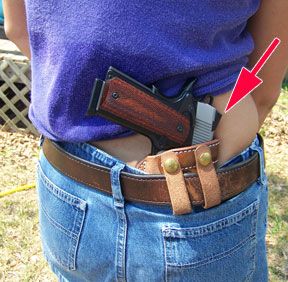
speed the XS sight gave excellent results.
The Novak, Heinie and McCormack sights were equal in dim light conditions as may be expected. The Trijicon, which was at a disadvantage in daylight firing due to the simpler sight configuration, was equal in night firing.
Fiber optics are very popular, and some claim the that fiber optics are as bright as night sights in some situations. In this area personal experience had to take precedence.
Although the new Novak fiber-optic front sight did fine during testing, past experience with factory optic front sights includes several losing the front sight insert. Among these was an expensive custom proposition in which the front sight of a Beretta 92 was cut out for a fiber optic insert. It lasted approximately 1,000 rounds before taking flight.
In general terms, we found that the Novak gold bead front sight is an elegant option appreciated by all who used it. The gold bead front sight shows up well in near-dim-light conditions.
With these general considerations out of the way, here are our specific recommendations in more detail:
Snag Testing
We wore IWB or tight-fitting pancake holsters under IDPA-type concealment vests and also used an IWB under a light garment against naked skin. We drew from concealed carry, not being particularly careful if the shirt were perfectly tucked in our jeans or trousers. We drew and fired at a 7-yard silhouette. We fired five shots one at a time for each handgun. We were looking for consistency. This drill combined the free-of-clothing test and the speed to a first shot.
Overall, our shooters said it was obvious that the larger the front sight, the better it performed in these drills. A sight that interrupted the shooters field of view while still in the peripheral vision resulted in faster and more accurate hits. They also rendered specific judments on each type of sight.Our Team Said:
GI Sight: Relatively clean. The low front sight never snags.
Mil Spec: Occasionally, the tall rear sight will catch on clothing if the sight is not perfectly angled away from clothing.
Trijicon: These sights are more squat and blocky than the Mil Spec and seemed snag free.
XS sights: The big dot front sight seemed to occasionally drag on the holster but never on clothing.
Novak: This sight simply does not drag.
Heinie: Has a broader real profile in custom applications. Just the same, the Heinie proved itself snag-free on the draw.
McCormick/Kimber: The Kimber pistols used were quite fast on the draw with no hint of snags.
Para Ordnance: The Para Ordnance sights were lower than some of the others and snag free.
Wilson Combat: Bill Wilsons idea concerning combat sights is a low pyramid with a minimum of sharp surfaces. Drag free.
Shooting Results: 7 Yards
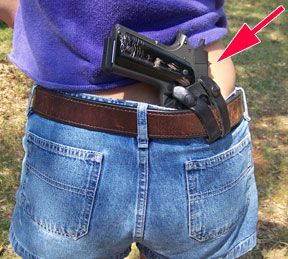
We used a variety of pistols with varying sight-radius measurements to ensure barrel length didnt introduce a hidden bias. Some of the pistols were 5-inch-barrel 1911 pistols, and the others were either 4- or 4.25-inch-barrel handguns. The longer pistol features a 6.5-inch sight radius, while the shorter handgun features a 5.75-inch sight radius.
In this part of the test, we fired at targets 7 yards away, attempting to keep the draw-and-fire time within a reasonable 1.25-second margin, which wouldnt allow our shooters more time to line up more-difficult-to-use smaller sights.
We first conducted “flash-sight-picture” shooting-we fired as soon as the front sight broke the plane between the eye and the target, attempting to get a good sight picture.Our Team Said:
GI SIGHTS: These sights are the reason that point-shooting disciplines were once popular-there is not much to work with. These sights received poor ratings.
Mil Spec: These sights were not the improvement you may wish for. They are marginally better than GI sights.
Trijicon: Trijicon sights are little larger than Mil Spec, but the tritium insert gave an advantage.
XS SIGHTS: The XS was the fastest of all sights tested at 7 yards. Put the dot on the target and press the trigger.
Novak: The Novak is a very credible sight that must have been what Jeff Cooper was thinking about when he said, “Front sight, press.”
Heinie: Many shooters remarked that the bold solid black rear sight of the Heinie really caught their eyes and led them to the target. They usually picked up the rear sight before the front sight.
Kimber: The Kimber was more like the Heinie than the Novak, and posted good results.
Para Ordnance: This small sight has a different angle than most, and was hard to get used to. Results were acceptable.
Wilson Combat: Worked well for all shooters.
Shooting Results: 10 Yards
This is a test of sight picture at moderate range. At 10 yards we fired ten shots as quickly as we could line the sights up again after recoil, off hand. The experienced shooter knows that a well-aimed cadence of fire is not set by how quickly you are able to press the
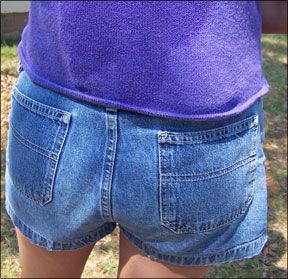
trigger but by how quickly you are able to draw the front sight back into the rear sight and control the sight picture. Our Team Said:
GI Sights: These sights are usually well regulated for 230-grain ball ammunition. This proved true, but the GI sights are at a disadvantage in accuracy. It takes longer to line these sights up between shots.
Mil Spec: Somewhat better than the GI sight.
Trijicon: Trijicon sights did well, not only on the 1911 but in the case of the Smith & Wesson M&P 9mm.
XS SIGHTS: The XS sight performed well. However, we sensed the XS was at the end of its most useful range. You cannot lower the gun, aim again, and cut bullet holes. The hole will be in a different place due to the design of the round-dot sight.
Novak: The Novak equaled the XS for practical purposes with a smaller group on average.
Heinie: The Heinie sight is accurate. On average, it offered smaller groups with slightly less speed compared to Novak.
Kimber: Excellent all-round results.
Para Ordnance: These low-mount sights are generally serviceable, but at a disadvantage compared to the Novak sights.
Wilson Combat: We were beginning to detect a trend for good accuracy with these.
Shooting Results: 25 Yards
We fired from a solid benchrest at 25 yards. At this point it was almost a waste of ammunition to test the GI guns, but we persevered. While the handguns seemed mechanically accurate, it is not in the cards for a GI pistol to group into less than 4 inches with the issue sights. But we took these factors into consideration when we were assessing sight precision. Our Team Said:
GI Sights: May be precise if properly lined up, but it takes too much time.
Mil Spec: No better than GI sights from the bench.
Trijicon: Better than GI sights off the bench.
XS SIGHTS: Repeatability problems. Not a good choice for long range, our testers said, but far from useless.
Novak: The Novak-equipped guns tested were the most accurate. Good results.
Heinie: A good sight picture and excellent potential accuracy, depending on the gun.
Kimber: These sights are an option to the Novak.
Para Ordnance: The sight picture seemed crowded, but the results were credible.
Wilson Combat: Several shooters remarked upon the “fineness” of the sight picture. An excellent custom option for the shooter who wants to upgrade an older gun.



























